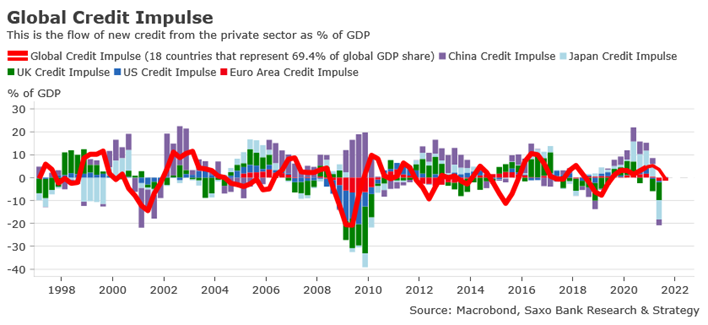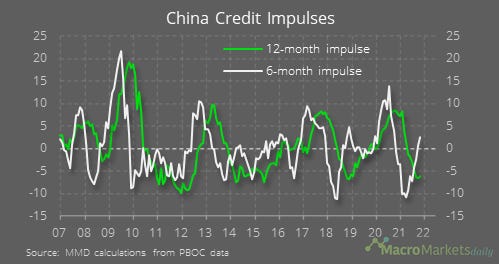Correction below.
Original post:
What's this have to do with the price of copper in China?
And will China start tearing down those 90 million empty apartments and recycling the metals?
So many questions.
First up, from Saxo Bank, December 17:
Chart of the Week : Global Credit Impulse Update
The economist consensus is optimistic about economic growth in 2022. Financial conditions will remain broadly accommodative despite monetary policy tightening. With a faster vaccine rollout and new Covid antibody cocktails, the pandemic will be under control, at least in the developed world. The direct inflationary effect of bottlenecks will progressively vanish. On the production side, supply will increase and will reduce the risk of shortage. But what if the consensus is wrong ? Our proprietary leading indicator for growth, the global credit impulse, flashes a warning to major economies. It tracks the flow of new credit issued by the private sector as a percentage of GDP. In our sample, we have the eighteenth largest economies which represent 69.4 % of global GDP share. The global credit impulse is now in contraction territory, running at minus 1.3 % of global growth, according to our preliminary estimates. When the credit impulse is negative, expect that growth will cool down significantly in the next six to nine months afterwards. Said differently, we could see growth slowdown from Q2-Q3 onwards in 2022. This has not been priced in by any investors at that stage. Both short- and medium-term factors explain the contraction in the global credit impulse : the contraction in the flow of new credit in most developed countries (the United Kingdom, the euro area and Japan, for instance) and the tight monetary and fiscal policies implemented by China since early 2021. This has been recently reversed. But it will take time before it has a net positive global effect on growth. Our leading indicator has a very good track record. If it proves to be right once more, the year 2022 could be less quiet than most currently anticipate on the macroeconomic front.

What is Saxo Credit Impulse ?
The notion of Credit Impulse was introduced for the first time by Michael Biggs in November 2008. The Credit Impulse represents the flow of new credit issued from the private sector as a percentage of GDP. It is the second derivative of credit growth and arguably the largest driver behind economic growth.
....MUCH MORE, including download option
And from MacroMarketsDaily, December 13 (note the positivity of the 6-month):
China's credit impulse improving
Six-month impulse now positive
Chart of the Day
The Chinese credit data for November were out late last week and showed that the flow of credit is picking up again. Our six-month credit impulse, which basically shows the rate of change of the six-month flow of credit, has now turned positive. This is important for many markets, especially commodities, of which China is often the world’s most important buyer. The improvement in credit in China comes at a time when US GDP growth is also accelerating and means we could be in for a strong H1 next year, so long as Omicron does not prove too disruptive....
....MUCH MORE
"CORRECTION—China Does NOT Have 90 Million Empty Apartments"
